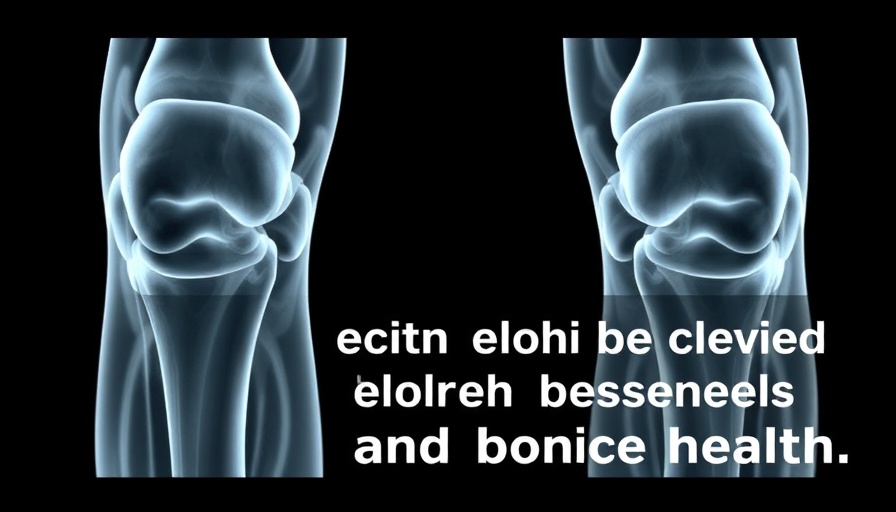
Unlocking the Secrets of Bone and Joint Health
Our bones and joints may often be overlooked, but they play critical roles in our overall health and mobility. With an aging population and a rise in physical activity among all age groups, understanding how to take care of these vital components of our bodies has never been more crucial. Supplements can provide a boost in maintaining their strength and function. Here, we unveil the essential vitamins and minerals crucial for bone and joint health.
Calcium: The Foundation of Strong Bones
Calcium is fundamental to bone health, with over 99% of the body's calcium stored in the teeth and bones, performing essential functions including muscle contraction and hormone release. Unfortunately, many of us do not get enough calcium through our diet, especially women after menopause who experience significant bone loss due to declining estrogen levels. Studies suggest that calcium supplementation can mitigate this loss, particularly in individuals with low dietary calcium intake. This makes it a cornerstone for anyone looking to strengthen their bones.
Vitamin D: The Sunshine Nutrient
Vitamin D, often dubbed the sunshine vitamin, plays a vital role in calcium absorption and bone integrity. Age-related deficiencies in vitamin D can lead to weakened bones and diseases like osteoporosis. Research indicates that supplementing those with existing deficiencies can build bone density and significantly reduce the risk of fractures, particularly in older adults. Supplements combining both calcium and vitamin D have been shown to reduce fracture risk effectively. Making sure you have adequate vitamin D levels could be one of the easiest steps toward better bone health.
Vitamin K: A Hidden Treasure
While calcium and vitamin D often take the spotlight, vitamin K should not be underestimated. This nutrient helps regulate calcium in the bones, ensuring that it is properly utilized. Recent reviews demonstrate that combining vitamin K with calcium can boost lumbar bone mineral density, showcasing its importance. As we learn more about this vitamin, its role solidifies as a crucial player in the quest for optimal joint and bone health.
Magnesium: Essential for Bone Density
Contrary to popular belief, bones aren't just made of calcium; magnesium, which constitutes around 60% of the body’s magnesium stores, is equally important. Studies suggest that magnesium supplementation can improve bone density and reduce the risk of fractures. As we age, magnesium levels can decline, so ensuring we have an adequate intake through supplements may preserve our bone health and strength.
Collagen: The Joint Support Superstar
Technology hasn’t only improved how we live; it has also advanced our understanding of nutrition. Collagen, a protein that serves as a building block for our joints, has gained attention for its potential to improve joint health. Clinical studies have reported that collagen supplements enhance joint comfort and mobility, which is particularly beneficial for those engaged in physical training or experiencing age-related joint concerns.
Considerations Before Starting Supplements
Before adding any new supplement to your regimen, it's advisable to consult with healthcare professionals, especially if you have existing health conditions or are taking medications. Not all supplements are created equal - ensuring that the product you choose is of high quality and sourced from reputable manufacturers is crucial. It’s also important to remember that supplements are a supporting ally, not a replacement for a balanced diet or healthy lifestyle.
Actionable Insights for a Healthier Future
Empowering yourself with knowledge about bone and joint health allows you to take proactive steps towards wellness. Consider integrating calcium, vitamin D, vitamin K, magnesium, and collagen into your daily routine. Alongside these supplements, prioritize a balanced diet rich in whole foods, engage in regular physical activity to enhance strength and flexibility, and promote overall well-being through mindfulness and stress management techniques.
Conclusion: Your Path to Stronger Bones
Nurturing your bones and joints through prudent nutritional and lifestyle choices ensures you remain active and healthy as you age. By making informed decisions about dietary supplements while fostering a healthy environment for your body, you pave the way for enhanced vitality. Explore these supplements and their remarkable benefits for a more durable and healthier life!
 Add Row
Add Row  Add
Add 




Write A Comment